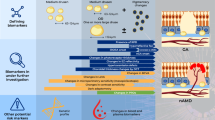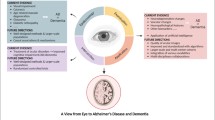Abstract
Objectives
To evaluate the retinal and choriocapillaris vascular networks in macular region and the central choroidal thickness (CCT) in patients affected by Huntington disease (HD), using optical coherence tomography angiography (OCTA) and enhanced depth imaging spectral-domain OCT (EDI SD-OCT).
Methods
We assessed the vessel density (VD) in superficial capillary plexus (SCP), deep capillary plexus (DCP), and choriocapillaris (CC) using OCTA, while CCT was measured by EDI SD-OCT.
Results
Sixteen HD patients (32 eyes) and thirteen healthy controls (26 eyes) were enrolled in this prospective study. No significant difference in retinal and choriocapillaris VD was found between HD patients and controls while CCT turned to be thinner in patients respect to controls. There were no significant relationships between OCTA findings and neurological parameters.
Conclusion
The changes in choroidal structure provide useful information regarding the possible neurovascular involvement in the physiopathology of HD. Choroidal vascular network could be a useful parameter to evaluate the vascular impairment that occurs in this neurodegenerative disease.

Similar content being viewed by others
References
Walker FO (2007) Huntington's disease. Lancet 369:218–228
Tabrizi SJ, Ghosh R, Blair R, Leavitt BR (2019) Huntingtin lowering strategies for disease modification in Huntington's disease. Neuron 101:801–819
Zeun P, Scahill RI, Tabrizi SJ, Wild EJ (2019) Fluid and imaging biomarkers for Huntington's disease. Mol Cell Neurosci 97:67–80
Huang D, Swanson EA, Lin CP, Schuman JS, Stinson WG, Chang W, Hee M, Flotte T, Gregory K, Puliafito C (1991) Optical coherence tomography. Science 254:1178–1181
Mrejen S, Spaide RF (2013) Optical coherence tomography: imaging of the choroid and beyond. Surv Ophthalmol 58:387–429
Sakai RE, Feller DJ, Galetta KM, Galetta SL, Balcer LJ (2011) Vision in multiple sclerosis: the story, structure-function correlations, and models for neuroprotection. J Neuroophthalmol 31:362–373
Kersten HM, Danesh-Meyer HV, Kilfoyle DH, Roxburgh RH (2015) Optical coherence tomography findings in Huntington's disease: a potential biomarker of disease progression. J Neurol 262:2457–2465
Andrade C, Beato J, Monteiro A, Costa A, Penas S, Guimarães J (2016) Spectral-domain optical coherence tomography as a potential biomarker in Huntington's disease. Mov Disord 31:377–783
Lin CY, Hsu YH, Lin MH, Yang TH, Chen HM, Chen YC, Hsiao HY, Chen CC, Chern Y, Chang C (2013) Neurovascular abnormalities in humans and mice with Huntington's disease. Exp Neurol 250:20–30
Drouin-Ouellet J, Sawiak SJ, Cisbani G, Lagacé M, Kuan WL, Saint-Pierre M, Dury RJ, Alata W, St-Amour I, Mason SL, Calon F, Lacroix S, Gowland PA, Francis ST, Barker RA, Cicchetti F (2015) Cerebrovascular and blood-brain barrier impairments in Huntington’s disease: potential implications for its pathophysiology. Ann Neurol 78:160–177
Patton N, Aslam T, MacGillivray T, Pattie A, Deary IJ, Dhillon B (2005) Retinal vascular image analysis as a potential screening tool for cerebrovascular disease: a rationale based on homology between cerebral and retinal microvasculatures. J Anat 206:319–348
London A, Benhar I, Schwartz M (2013) The retina as a window to the brain-from eye research to CNS disorders. Nat Rev Neurol 9:44–53
Wang Q, Chan S, Yang JY, You B, Wang YX, Jonas JB, Wei WB (2016) Vascular density in retina and choriocapillaris as measured by optical coherence tomography angiography. Am J Ophthalmol 168:95–109
Kniestedt C, Stamper RL (2003) Visual acuity and its measurement. Ophthalmol Clin N Am 16:155–170
Lanzillo R, Cennamo G, Criscuolo C, Carotenuto A, Velotti N, Sparnelli F, Cianflone A, Moccia M, Brescia Morra V (2018) Optical coherence tomography angiography retinal vascular network assessment in multiple sclerosis. Mult Scler 24:1706–1714
Spaide RF, Koizumi H, Pozzoni MC, Pozonni MC (2008) Enhanced depth imaging spectral-domain optical coherence tomography. Am J Ophthalmol 146:496–500
Jia Y, Tan O, Tokayer J, Potsaid B, Wang Y, Liu JJ, Kraus MF, Subhash H, Fujimoto JG, Hornegger J, Huang D (2012) Split spectrum amplitude-decorrelation angiography with optical coherence tomography. Opt Express 20:4710–4725
Huang D, Jia Y, Gao SS, Lumbroso B, Rispoli M (2016) Optical coherence tomography angiography using the optovue device. Dev Ophthalmol 56:6–12
Core Team R (2018) R: a language and environment for statistical computing. In: R Foundation for statistical computing. Austria. URL, Vienna https://www.R-project.org/
Bates D, Maechler M, Bolker B, Walker S (2015) Fitting linear mixed-effects models using lme4. J Stat Softw 67:1–48
Paulus W, Schwarz G, Werner A, Lange H, Bayer A, Hofschuster M, Müller N, Zrenner E (1993) Impairment of retinal increment thresholds in Huntington's disease. Ann Neurol 34(4):574–578
Li M, Yasumura D, Ma AA, Matthes MT, Yang H, Nielson G et al (2013) Intravitreal administration of HA-1077, a ROCK inhibitor, improves retinal function in a mouse model of Huntington disease. PLoS One 8:e56026
Batcha AH, Greferath U, Jobling AI, Vessey KA, Ward MM, Nithianantharajah J, Hannan AJ, Kalloniatis M, Fletcher EL (2012) Retinal dysfunction, photoreceptor protein dysregulation and neuronal remodelling in the R6/1 mouse model of Huntington’s disease. Neurobiol Dis 45:887–896
Helmlinger D, Yvert G, Picaud S, Merienne K, Sahel J, Mandel J-L, Devys D (2002) Progressive retinal degeneration and dysfunction in R6 Huntington’s disease mice. Hum Mol Genet 11:3351–3359
Johnson MA, Gelderblom H, Rüther K, Priller J, Bernstein SL (2014) Evidence that Huntington’s disease affects retinal structure and function. Invest Ophthalmol Vis Sci 55:1644
Gatto E, Parisi V, Persi G, Rey EF, Cesarini M, Etcheverry JS et al (2018) Optical coherence tomography (OCT) study in Argentinean Huntington’s disease patients. Int J Neurosci 128:1157–1162
Sevim DG, Unlu M, Gultekin M, Karaca C (2018) Retinal single-layer analysis with optical coherence tomography shows inner retinal layer thinning in Huntington's disease as a potential biomarker. Int Ophthalmol 39:611–621
Mironov V, Hritz MA, LaManna JC, Hudetz AG, Harik SI (1994) Architectural alterations in rat cerebral microvessels after hypobaric hypoxia. Brain Res 660:73–80
Sekhon LH, Morgan MK, SpenceI (197) Normal perfusion pressure breakthrough: the role of capillaries. J. Neurosurg. 86: 519–524
Wolf RC, Gron G, Sambataro F, Vasic N, Wolf ND, Thomann PA et al (2011) Magnetic resonance perfusion imaging of resting-state cerebral blood flow in preclinical Huntington's disease. J Cereb Blood Flow Metab 31:1908–1918
Harris GJ, Codori AM, Lewis RF, Schmidt E, Bedi A, Brandt J (1999) Reduced basal ganglia blood flow and volume in pre-symptomatic, gene-tested persons at-risk for Huntington's disease. Brain 122:1667–1678
Duran-Vilaregut J, del Valle J, Manich G, Camins A, Pallas M, Vilaplana J, Pelegri C (2011) Role of matrix metalloproteinase-9 (MMP-9) in striatal blood–brain barrier disruption in a 3-nitropropionic acid model of Huntington's disease. Neuropathol Appl Neurobiol 37:525–537
Author information
Authors and Affiliations
Contributions
Conceptualization: Giuseppe De Michele, Gilda Cennamo
Methodology: Gilda Cennamo, Daniela Montorio, Laura Giovanna Di Maio
Formal analysis and investigation: Laura Giovanna Di Maio, Daniela Montorio, Pasquale Dolce, Elena Salvatore
Writing—original draft preparation: Daniela Montorio, Silvio Peluso
Writing—review and editing: Daniela Montorio
Supervision: Giuseppe De Michele, Gilda Cennamo.
Corresponding author
Ethics declarations
Conflict of interest
The authors declare that they have no conflict of interest.
Ethical approval
All procedures performed in studies involving human participants were in accordance with the ethical standards of the institutional and/or national research committee and with the 1964 Helsinki Declaration and its later amendments or comparable ethical standards.
Informed consent
Informed consent was obtained from all individual participants included in the study002E.
Additional information
Publisher’s note
Springer Nature remains neutral with regard to jurisdictional claims in published maps and institutional affiliations.
Rights and permissions
About this article
Cite this article
Di Maio, L.G., Montorio, D., Peluso, S. et al. Optical coherence tomography angiography findings in Huntington’s disease. Neurol Sci 42, 995–1001 (2021). https://doi.org/10.1007/s10072-020-04611-2
Received:
Accepted:
Published:
Issue Date:
DOI: https://doi.org/10.1007/s10072-020-04611-2




